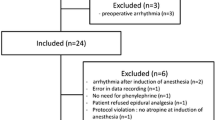Abstract
Introduction.Distal arterial pressure normally differs from aorticpressure. This difference is modified by changes of vascular resistance.Hemodilution, due to decreased viscosity, decreases vascular resistance.Therefore, the difference between aortic and distal arterial pressures couldbe altered as well. We investigated whether acute hemodilution affected thisdifference in dogs. Methods.Eleven mongrel dogs weighing 16.6 ±4.4 kg were anesthetized with pentobarbital and sufentanyl and mechanicallyventilated. Arterial presssure was recorded using Millar catheter-tippedpressure transducers in the proximal aorta and in the distal femoral artery.An electromagnetic flowmeter probe was placed around the aorta. Effectivedownstream pressure was estimated by extrapolation of exponential arterialpressure decay during 3-second occlusion of the proximal aorta. Hemodilutionwas effected by removal of 30 ml/kg of blood and replacement with 60 ml/kg ofwarmed saline. In addition, the effects of 1 µg/kg phenylephrine and 4µg/kg of sodium nitroprusside were measured before and afterhemodilution. Results.Hemodilution decreased hematocrit from 39± 11.2% to 25.6 ± 4.95%. Systolic and mean pressures wereunchanged but aortic diastolic pressure decreased significantly, from 86± 17 to 79 ± 15 mmHg (p < 0.005). Peak systolicpressure was 13.5 ± 7.2 mmHg higher in the femoral artery than in theaorta before, and 16 ± 8.7 mmHg after, hemodilution (p >0.05). Nitroprusside decreased the femoral to aortic peak systolic pressuredifference from 14.3 ± 6.3 to 7.7 ± 15.3 mmHg, p = 0.05before hemodilution and from 14.3 ± 8.8 to 2.5 ± 11 mmHg,p < 0.005 afterwards. Hemodilution significantly decreased theeffective downstream pressure, from 44 ± 9 to 36 ± 6.8 mmHg inthe aorta (p< 0.05), and from 51 ± 2 to 37 ± 3.1mmHg in the distal femoral artery (p< 0.05). Conclusion.Acute hemodilution did not alter the aortic-to-distal arterial pressuredifference in dogs.
Similar content being viewed by others
REFERENCES
Milnor WR. Hemodynamics, 2nd edition.Williams and Wilkins, Baltimore 1989: 146–160
Nichols WW, O'Rourke MF (editors). McDonald's blood £ow in arteries, 3rd edition. Edward Arnold, London 1990 and Lea and Febiger, Philadelphia 1990: 216–250
Dinnar U. Cardiovascular Dynamics. CRC Press, Boca Raton 1981: 23–31, 81–109
Burton AC. Physiology and biophysics of the circulation, 2nd Edition.Year Book Medical Publishers, Inc., Chicago 1972: 63–94
Rowell LB, Brengelman GL, Blackmon JR et al. Dispar-ities between aortic and peripheral pulse pressures in-duced by upright exercise and vasomotor changes in man. Circulation 1968; 37: 954–964
Mu·oz HR, Sacco CM. Cardiac mechanical energy and e¡ects on the arterial tree. J CardiothorVasc Anesth 1997; 11: 289–298
Urzua J. Aortic-to-radial arterial pressure gradient after bypass. Anesthesiology 1990; 73: 191
Pauca AL, Hudspeth AS, Wallenhaupt SL et al. Radial artery-to-aorta pressure di¡erence after discontinuation of cardiopulmonary bypass. Anesthesiology 1989; 90: 935–941
Gravlee GP, Brauer SD, O'Rourke MF, Avolio AP. A comparison of brachial, femoral, and aortic intra-arterial pressures before and after cardiopulmonary bypass. Anaesth Intens Care 1989; 17: 305–311
Urzua J. Vasodilator-induced femoral-to-radial pressure gradient after cardiopulmonary bypass. Anesth Analg 1990; 71: 710–711
Maruyama K, Horiguchi R, Hashimoto H et al. E¡ect of combined infusion of nitroglycerin and nicardipine on femoral-to-radial arterial pressure gradient after cardio-pulmonary bypass. Anesth Analg 1990; 70: 428–432
Pauca AL, Wallenhaupt SL, Kon ND. Reliability of the radial arterial pressure during anesthesia. Is wrist compres-sion a possible diagnostic test? Chest 1994; 105: 69–75
Urzua J, Sessler D, Meneses G et al. Thermoregulatory vasoconstriction increases the di¡erence between femoral and radial arterial pressures. J Clin Monit 1994; 10: 229–236
Urzua J, Zurick AM, Starr NJ et al. Enhanced cardiac performance following cardiopulmonary bypass. J Car-diovasc Surg 1985; 26: 53–58
Magder S. Starling resistor versus compliance. Circulat Res 1990; 67: 209–220
Permutt S, Riley RL. Hemodynamics of collapsible vessels with tone: The vascular waterfall. J Appl Physiol 1963; 18: 924–932
Strackee J, Westerhof N (editors). The physics of heart and circulation. The Institute of Physics Publishing, Bristol 1993: 394–395
Drossner M, Aversano T. E¡ect of perfusate rheology on the diastolic coronary pressure-£ow relationship. Am J Physiol 1990; 259: H603-H609
Doss DN, Estafanous FG, Ferrario CM et al. Mechanism of systemic vasodilation during normovolemic hemodi-lution. Anesth Analg 1995; 81: 30–34
Urzua J, Meneses G, Fajardo C et al. Arterial pressure-£ow relationship in patients undergoing cardiopulmo-nary bypass. Anesth Analg 1997; 84: 958–963
Author information
Authors and Affiliations
Rights and permissions
About this article
Cite this article
Urzua, J., Nunez, G., Lema, G. et al. Hemodilution does not Alter the Aortic-to-Femoral Arterial Pressure Difference in Dogs. J Clin Monit Comput 15, 429–433 (1999). https://doi.org/10.1023/A:1009986327155
Issue Date:
DOI: https://doi.org/10.1023/A:1009986327155




